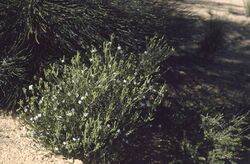Biology:Philotheca thryptomenoides
| Philotheca thryptomenoides | |
|---|---|

| |
| Near Beacon | |
| Scientific classification | |
| Kingdom: | Plantae |
| Clade: | Tracheophytes |
| Clade: | Angiosperms |
| Clade: | Eudicots |
| Clade: | Rosids |
| Order: | Sapindales |
| Family: | Rutaceae |
| Genus: | Philotheca |
| Species: | P. thryptomenoides
|
| Binomial name | |
| Philotheca thryptomenoides (S.Moore) Paul G.Wilson[1]
| |
| Synonyms[1] | |
| |
Philotheca thryptomenoides is a species of flowering plant in the family Rutaceae and is endemic to the south-west of Western Australia. It is a small undershrub with oval to club-shaped leaves and white flowers with a broad, reddish-brown stripe, arranged singly on the ends of branchlets.
Description
Philotheca thryptomenoides is an undershrub that typically grows to a height of about 50 cm (20 in) and has smooth, dark-coloured to black branchlets. The leaves are oval to club-shaped, 1.5–3 mm (0.059–0.118 in) long and flat on the upper surface. The flowers are arranged singly on the ends of branchlets and are sessile or on a pedicel up to 2 mm (0.079 in) long. The five sepals are egg-shaped, 2–3 mm (0.079–0.118 in) long, and the five petals are narrowly egg-shaped, white with a central reddish-brown stripe and about 6 mm (0.24 in) long. The ten stamens are free from each other and densely hairy. Flowering occurs from July to September and the fruit is 1.5–2 mm (0.059–0.079 in) long.[2][3][4]
Taxonomy
This species was first described in 1920 by Spencer Le Marchant Moore who gave it the name Erisotemon thryptomenoides in the Journal of the Linnean Society, Botany.[5][6] In 1998, Paul Wilson changed the name to Philotheca thryptomenoides in the journal Nuytsia.[7][8]
Distribution and habitat
This philotheca grows in shrubland on heavy soil in the Merredin-Wubin area in the south-west of Western Australia.[3]
Conservation status
Philotheca thryptomenoides is classified as "not threatened" by the Government of Western Australia Department of Parks and Wildlife.[2]
References
- ↑ 1.0 1.1 "Philotheca thryptomenoides". Australian Plant Census. https://biodiversity.org.au/nsl/services/apc-format/display/162026. Retrieved 14 August 2020.
- ↑ 2.0 2.1 "Philotheca thryptomenoides". FloraBase. Western Australian Government Department of Parks and Wildlife. https://florabase.dpaw.wa.gov.au/browse/profile/18507.
- ↑ 3.0 3.1 Wilson, Paul G.; Wilson, Annette J.G. (ed.) (2013). Flora of Australia (Volume 26). Canberra: Australian Biological Resources Study. p. 387. https://profiles.ala.org.au/opus/foa/profile/Philotheca%20thryptomenoides. Retrieved 14 August 2020.
- ↑ Wilson, Paul G. (1970). "A taxonomic revision of the genera Crowea, Eriostemon and Phebalium (Rutaceae)". Nuytsia 1 (1): 37. https://www.biodiversitylibrary.org/item/223300#page/43/mode/1up. Retrieved 14 August 2020.
- ↑ "Eriostemon thryptomenoides". APNI. https://id.biodiversity.org.au/instance/apni/501045. Retrieved 14 August 2020.
- ↑ Moore, Spencer Le Marchant (1920). "A contribution to the Flora of Australia.". Journal of the Linnean Society, Botany 45: 166. https://www.biodiversitylibrary.org/item/8410#page/180/mode/1up. Retrieved 14 August 2020.
- ↑ "Philotheca thryptomenoides". APNI. https://id.biodiversity.org.au/instance/apni/557418. Retrieved 14 August 2020.
- ↑ Wilson, Paul G. (1998). "A Taxonomic Review of the genera Eriostemon and Philotheca". Nuytsia 12 (2): 255. https://www.biodiversitylibrary.org/item/226456#page/101/mode/1up. Retrieved 14 August 2020.
Wikidata ☰ Q18075423 entry
 |

